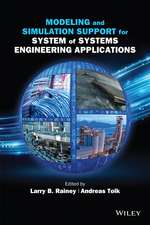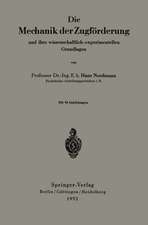Optical and Laser Remote Sensing: Springer Series in Optical Sciences, cartea 39
Editat de D.K. Killinger, A. Mooradianen Limba Engleză Paperback – 3 oct 2013
Din seria Springer Series in Optical Sciences
- 24%
 Preț: 945.45 lei
Preț: 945.45 lei - 18%
 Preț: 1850.21 lei
Preț: 1850.21 lei - 18%
 Preț: 2124.06 lei
Preț: 2124.06 lei - 20%
 Preț: 568.46 lei
Preț: 568.46 lei - 18%
 Preț: 1118.93 lei
Preț: 1118.93 lei - 18%
 Preț: 999.76 lei
Preț: 999.76 lei - 18%
 Preț: 957.62 lei
Preț: 957.62 lei - 18%
 Preț: 892.11 lei
Preț: 892.11 lei - 15%
 Preț: 648.56 lei
Preț: 648.56 lei - 18%
 Preț: 1838.07 lei
Preț: 1838.07 lei -
 Preț: 379.86 lei
Preț: 379.86 lei - 18%
 Preț: 1392.95 lei
Preț: 1392.95 lei - 18%
 Preț: 1232.89 lei
Preț: 1232.89 lei - 18%
 Preț: 1568.95 lei
Preț: 1568.95 lei - 18%
 Preț: 2095.49 lei
Preț: 2095.49 lei - 18%
 Preț: 1227.84 lei
Preț: 1227.84 lei - 15%
 Preț: 643.65 lei
Preț: 643.65 lei - 18%
 Preț: 954.45 lei
Preț: 954.45 lei - 18%
 Preț: 947.35 lei
Preț: 947.35 lei - 18%
 Preț: 1241.55 lei
Preț: 1241.55 lei - 18%
 Preț: 947.04 lei
Preț: 947.04 lei -
 Preț: 392.21 lei
Preț: 392.21 lei - 18%
 Preț: 997.53 lei
Preț: 997.53 lei - 18%
 Preț: 1562.31 lei
Preț: 1562.31 lei - 18%
 Preț: 1110.24 lei
Preț: 1110.24 lei - 15%
 Preț: 651.19 lei
Preț: 651.19 lei -
 Preț: 414.69 lei
Preț: 414.69 lei - 18%
 Preț: 952.57 lei
Preț: 952.57 lei - 15%
 Preț: 641.03 lei
Preț: 641.03 lei - 15%
 Preț: 635.80 lei
Preț: 635.80 lei
Preț: 394.12 lei
Nou
Puncte Express: 591
Preț estimativ în valută:
75.42€ • 78.94$ • 62.77£
75.42€ • 78.94$ • 62.77£
Carte tipărită la comandă
Livrare economică 31 martie-14 aprilie
Preluare comenzi: 021 569.72.76
Specificații
ISBN-13: 9783662157367
ISBN-10: 3662157365
Pagini: 400
Ilustrații: X, 386 p. 145 illus.
Dimensiuni: 155 x 235 x 21 mm
Greutate: 0.56 kg
Ediția:Softcover reprint of the original 1st ed. 1983
Editura: Springer Berlin, Heidelberg
Colecția Springer
Seria Springer Series in Optical Sciences
Locul publicării:Berlin, Heidelberg, Germany
ISBN-10: 3662157365
Pagini: 400
Ilustrații: X, 386 p. 145 illus.
Dimensiuni: 155 x 235 x 21 mm
Greutate: 0.56 kg
Ediția:Softcover reprint of the original 1st ed. 1983
Editura: Springer Berlin, Heidelberg
Colecția Springer
Seria Springer Series in Optical Sciences
Locul publicării:Berlin, Heidelberg, Germany
Public țintă
ResearchCuprins
1 IR Differential-Absorption LIDAR (DIAL) Techniques.- 1.1 Airborne Remote Sensing Measurements With a Pulsed CO2 Dial System.- 1.2 Differential-Absorption Measurements With Fixed-Frequency IR and UV Lasers.- 1.3 Remote Sensing of Hydrazine Compounds Using a Dual Mini-TEA CO2 Laser DIAL System.- 1.4 The Hull Coherent DIAL Programme.- 1.5 Remote Measurement of Trace Gases With the JPL Laser Absorption Spectrometer.- 1.6 Laser Remote Sensing Measurements of Atmospheric Species and Natural Target Reflectivities.- 1.7 Airborne CO2 Laser Heterodyne Sensor for Monitoring Regional Ozone Distributions.- 2 Spectrometric Techniques.- 2.1 Tunable Laser Heterodyne Spectrometer Measurements of Atmospheric Species.- 2.2 Interferometric Measurements of Atmospheric Species.- 2.3 Remote Sensing by Infrared Heterodyne Spectroscopy.- 2.4 Detection of Trace Gases Using High-Resolution IR Spectroscopy.- 2.5 Gaseous Correlation Spectrometric Measurements.- 2.6 Measurements of Atmospheric Trace Gases by Long Path Differential UV/Visible Absorption Spectroscopy.- 2.7 Measurements of HONO, NO3, and NO2 by Long-Path Differential Optical Absorption Spectroscopy in the Los Angeles Basin.- 2.8 Remote Detection of Gases by Gas Correlation Spectroradiometry.- 3 UV-Visible DIAL Techniques.- 3.1 Atmospheric Pressure and Temperature Profiling Using Near IR Differential Absorption Lidar.- 3.2 Ground-Based Ultraviolet Differential Absorption Lidar (DIAL) System and Measurements.- 3.3 Remote Sensing of Tropospheric Gases and Aerosols With an Airborne DIAL System.- 3.4 Pollution Monitoring Using Nd:YAG Based Lidar Systems.- 4 Atmospheric Propagation and System Analysis.- 4.1 Effects of Atmospheric Obscurants on the Propagation of Optical/IR Radiation.- 4.2 The Effects of Target-Induced Speckle, AtmosphericTurbulence, and Beam Pointing Jitter on the Errors in Remote Sensing Measurements.- 4.3 Lidar System Analysis for Measurement of Atmospheric Species.- 4.4 CO2 DIAL Sensitivity Studies for Measurements of Atmospheric Trace Gases.- 4.5 Signal Averaging Limitations in Heterodyne- and Direct-Detection Laser Remote Sensing Measurements.- 5 UV-Fluorescence Remote Sensing.- 5.1 Rayleigh and Resonance Sounding of the Stratosphere and Mesosphere.- 5.2 High-Resolution Lidar System for Measuring the Spatial and Temporal Structure of the Mesospheric Sodium Layer.- 5.3 Remote Sensing of OH in the Atmosphere Using the Technique of Laser-Induced Fluorescence.- 5.4 Use of the Fraunhofer Line Discriminator (FLD) for Remote Sensing of Materials Stimulated to Luminesce by the Sun.- 5.5 Ozone and Water Vapor Monitoring Using a Ground-Based Lidar System.- 5.6 The NASA/Goddard Balloon Borne Lidar System.- 6 Laser Sources and Detectors.- 6.1 Development of Compact Excimer Lasers for Remote Sensing.- 6.2 Solid-State Laser Sources for Remote Sensing.- 6.3 Progress in Laser Sources for Remote Sensing.- 6.4 Review of NDRE Remote Sensing Program and Development of High Pressure RF Excited CO2 Waveguide Lasers.- 6.5 Progress in Dye and Excimer Laser Sources for Remote Sensing.- 6.6 IR Detectors: Heterodyne and Direct.- 7 Advanced Optical Techniques.- 7.1 Optical Remote Sensing of Environmental Pollution and Danger by Molecular Species Using Low-Loss Optical Fiber Network System.- 7.2 In situ Ultratrace Gas Detection by Photothermal Spectroscopy: An Overview.- 7.3 Laser-Induced Breakdown Spectroscopy (LIBS): A New Spectrochemical Technique.- 7.4 The High Spectral Resolution Lidar.- 8 Lidar Technology.- 8.1 Lidar Measurements of Clouds.- 8.2 Coherent IR Radar Technology.- 8.3 Tactical and AtmosphericCoherent Laser Radar Technology.- 8.4 Atmospheric Remote Sensing Using the NOAA Coherent Lidar System.- 8.5 Coherent CO2 Lidar Systems for Remote Atmospheric Measurements.- 8.6 Wide-Area Air Pollution Measurement by the NIES Large Lidar.- 8.7 ALPHA-1/Alarm Airborne Lidar Systems and Measurements.- Index of Contributors.
















